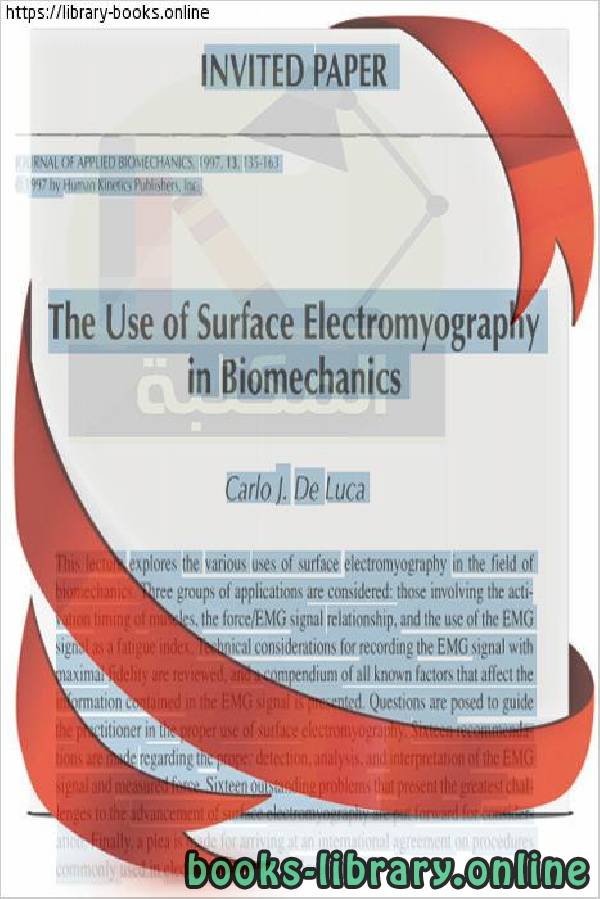📘 قراءة كتاب The Use of Surface Electromyography in Biomechanics أونلاين


Biologically
Biology is a natural science that is concerned with the study of life, its various forms and its function, how these organisms interact with each other and with the surrounding environment. The word biology in Greek is made up of two words: bio (βίος) meaning life. And loggia (-λογία) means science or study. Biology: the similarity of vegetation and animal cover on the edges of the African and American states, and the existence of the same fossil.
Branches of biology
Biology is an ancient science thousands of years old and modern biology began in the nineteenth century. This science has multiple branches. Among them are:
Anatomy
Botany
Biochemia
Biogeography
Biofisia
Cytology or cell science
Ecology or environmental science
نبذه عن الكتاب:
The Use of Surface Electromyography
in Biomechanics
Carlo I. De Luca
This lecture explores the various uses of surface electromyography in the field of
biomechanics. Three groups of applications are considered: those involving the activation timing of muscles, the force/EMG signal relationship, and the use of the EMG
signal as a fatigue index. Technical considerations for recording the EMG signal with
maximal fidelity are reviewed, and a compendium of all known factors that affect the
information contained in the EMG signal is presented. Questions are posed to guide
the practitioner in the proper use of surface electromyography. Sixteen recommendations are made regarding the proper detection, analysis, and interpretation of the EMG
signal and measured force. Sixteen outstanding problems that present the greatest challenges to the advancement of surface electromyography are put forward for consideration. Finally, a plea is made for arriving at an international agreement on procedures
commonly used in electromyography and biomechanics.
Electromyography is a seductive muse because it provides easy access to physiological processes that cause the rnuscle to generate force, produce movement, and accomplish the countless functions that allow us to interact with the world around us. The
current state of surface electromyography is enigmatic. It provides many important and
useful applications, but it has many limitations that must be understood, considered, and
eventually removed so that the discipline is more scientifically based and less reliant on
the art of use. To its detriment, electromyography is too easy to use and consequently too
easy to abuse.
The scope of this paper is not to review past contributions to the advancement of
electromyography in biomechanics. Many researchers have contributed to that chronicle. 1
Instead this discussion will focus on the complex and interrelated factors underlying the
relationship between the electromyographic (EMG) signal and the force produced by a
muscle. Many intricate issues will be raised to identify the intrinsic complexity of the
relationship. I hope that this discussion will raise awareness of the usefulness and limitaCarlo J. De Luca is with the NeuroMuscular Research Center and Biomedical Engineering
Department and Neurology Department, Boston University, 44 Cummington St., Boston, MA 02215.
This paper was presented to the International Society for Biomechanics in Paris on July 5,
1993, as the Wartenweiler Memorial Lecture.
'The list of contributors is long. The inclusionof a comprehensive bibliography would distract from the simplicity and clarity of the messages, which are the dominant features of the lecture.
This lecture is not intended to be a critical review. When necessary, I have referred only to my work
and to that of my scientific collaborators, knowing that by doing so, I run the risk of self-aggrandizement. Instead, I hope that the reader will accept the notion that this construct was intended to maintain neutrality among the many candidates who qualified for inclusion.
Biology
Human biology
Who is the founder of biology?
The importance of biology
Areas of work in the field of biology
Theories of biology
Research on biology for the first grade of secondary school
Human biology
حجم الكتاب عند التحميل : 4.867 .
نوع الكتاب : pdf.
عداد القراءة:
اذا اعجبك الكتاب فضلاً اضغط على أعجبني و يمكنك تحميله من هنا:

شكرًا لمساهمتكم
شكراً لمساهمتكم معنا في الإرتقاء بمستوى المكتبة ، يمكنكم االتبليغ عن اخطاء او سوء اختيار للكتب وتصنيفها ومحتواها ، أو كتاب يُمنع نشره ، او محمي بحقوق طبع ونشر ، فضلاً قم بالتبليغ عن الكتاب المُخالف:
 قبل تحميل الكتاب ..
قبل تحميل الكتاب ..
يجب ان يتوفر لديكم برنامج تشغيل وقراءة ملفات pdf
يمكن تحميلة من هنا 'http://get.adobe.com/reader/'


 منصّة المكتبة
منصّة المكتبة 